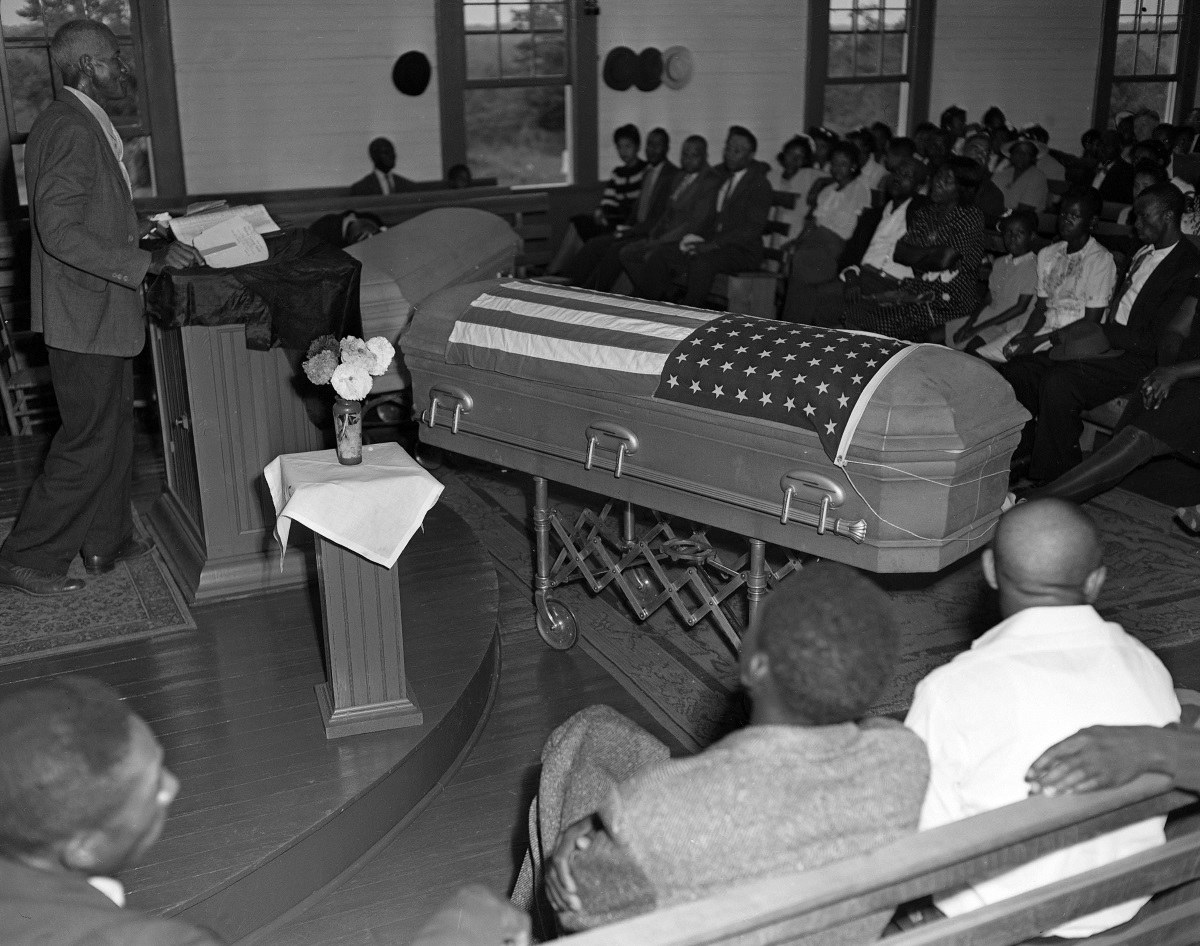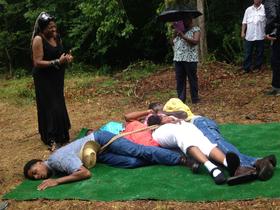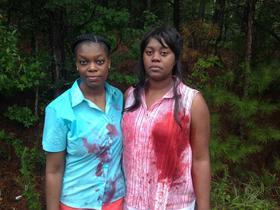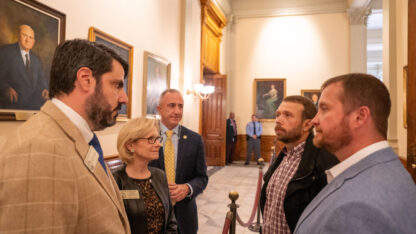Moore’s Ford Re-enactment Continues To Revisit 1946 Lynching

Editor’s note: This story includes material that may be offensive to some readers.
To re-enact a lynching, director Cassandra Greene relies on the same things you’d see in any play: costumes from the period, props like fake guns, and actors.
When Greene briefed her crew at the First African Baptist Church in Monroe, Georgia on Saturday, July 23, she informed them that they were low on actors this year. Only four or five white men showed up to play what was supposed to be a mob of Klansmen.
“We’ve worked with less than that,” Greene said. “So we’re going to be able to pull it off like we always do.”
For the 12th year, Greene and a group called the Moore’s Ford Movement brought to life the lynching of four African-Americans at Moore’s Ford Bridge at the edge of Walton County. On July 25, 1946, now 70 years ago, a group of unmasked white men dragged the two couples, Roger and Dorothy Malcolm and George and Mae Murray Dorsey, from a car and shot them.
As Greene prepared to start the event, which lasts hours and takes place at several locations throughout the county, she said finding white actors to fill the roles of the killers is always hard.
“It’s a challenge, because even my white friends who are actors don’t want to do it,” Greene said. “They’re like, ‘No, no I cannot play a Klansman.’”
And, she adds, the actors are especially reluctant to use offensive racial slurs.
“It is the one time in my life I’ve used the ‘N-word,’” said Bob Caine, who plays a Klansman and is one of the few white actors who returns each year.
Caine wore a shirt with peace sign printed on it before changing into costume. He said he doesn’t want to be associated with his character.
“I am not taking the Klan personality home with me. I’m wearing it for 20 minutes, but I take it off as quickly as I can,” Caine said.
Assuming the role of the victims can be difficult for the black actors, too.
The re-enactment opened at the church with a scene showing the knife fight between a white farmer and Roger Malcolm that fueled the lynching. The argument starts with the farmer yelling a racial slur repeatedly at Malcolm.
Twenty-one-year-old Darrius Bradshaw played Malcolm this year, the man who had been in the fight.
Later in the performance, in a scene at Moore’s Ford Bridge, the Klansmen ambushed Malcolm, as he sat in a car with his wife Dorothy Malcolm and George Dorsey and Mae Murray Dorsey. The white men put a noose around Malcolm’s neck.
Bradshaw said he remembers how the rope felt the first time.
“That’s something I definitely had to get over,” Bradshaw said. “I didn’t smile that much at the first rehearsal. I didn’t really talk that much at the first rehearsal. It was a lot.”
These feelings are why you don’t hear about re-enactments of lynchings, said Mark Auslander, a professor of anthropology and museum studies at Central Washington University.
“Everybody’s familiar with Civil War re-enactments that tend to emphasize a positive narrative of struggle and ultimately success and redemption,” said Auslander. “The thing about lynching is that’s very hard to find any redemptive narrative.”
Auslander has attended many of the Moore’s Ford Bridge performances. He said it’s the only annual re-enactment to face the history of lynchings in the U.S., which he describes as an open wound.
“It’s one thing to deal with it as in ‘12 Years a Slave,’” Auslander said. “But a physical re-enactment, where everybody’s right there, by untrained actors — it’s all the more painful watching that. That is just a very hard road to enter into.”
Over the years, many have disapproved of how the re-enactors choose to commemorate the event.
“I think it’s atrocious,” said Anthony Pitch, who wrote a book about the Moore’s Ford killings, called “The Last Lynching: How a Gruesome Mass Murder Rocked a Small Georgia Town.”
Pitch said he thinks the victims should be remembered, but in a “nicer” way. He pointed out that a multiracial group called the Moore’s Ford Memorial Committee once gave out scholarships in the two couples’ memory.
“To re-enact a horror story like this can only inflame races on both sides. It just encourages and ferments this kind of thing where people take sides,” said Pitch. “It’s a horrific incident.”
The re-enactment was also a passion project of former state lawmaker and civil rights activist Tyrone Brooks. His year-and-a-day prison sentence, which he started earlier this year, for mismanaging charity funds has complicated the performance in some people’s eyes.
But those who organize the re-enactment year after year stand by the event. Director Cassandra Greene said a memorial service or grave visit alone would not be enough to draw attention to the unsolved lynching.
“We’ve seen that whatever we do to commemorate people that are killed — especially black people — it’s not enough, because it’s still going on,” Greene said.
By the time the re-enactment reached the final scene in the field by Moore’s Ford Bridge, a crowd of a hundred or so had gathered. Most in the audience were black. Several wore Black Lives Matter T-shirts.
At this point in the story, the white Klansmen had taken the noose off Malcolm and used it to tie up him, his wife and George and Mae Murray Dorsey. Then, the Klansmen pointed their guns.
To Greene and many of those watching, this re-enactment wasn’t only about the past.










